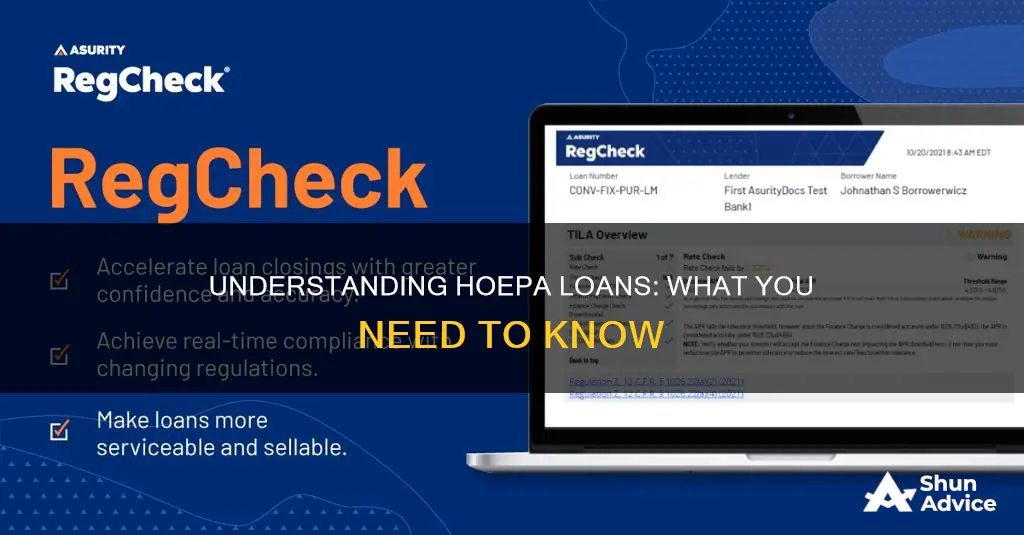
The Home Ownership and Equity Protection Act, or HOEPA, is a federal law enacted in 1994 to protect consumers from predatory mortgage lending. HOEPA covers high-cost mortgages, defined as loans with an annual percentage rate (APR) that exceeds the prime rate by a certain amount. The law requires lenders to provide borrowers with disclosures about the loan's lifetime cost and the consequences of default. HOEPA also restricts certain loan terms, such as late fees, prepayment penalties, and non-amortizing payment schedules, and prohibits creditors from charging fees for modifying or extending high-cost mortgages.
What You'll Learn

HOEPA's definition of a high-cost mortgage
The Home Ownership and Equity Protection Act (HOEPA) is a federal law that aims to protect consumers from predatory mortgage lending. HOEPA covers high-cost mortgages, which are defined as loans with an annual percentage rate (APR) that exceeds the prime rate by a certain amount.
HOEPA defines a high-cost mortgage as "any consumer credit transaction that is secured by the consumer’s principal dwelling". This means that the loan is secured by the borrower's primary residence. For a loan to be considered a high-cost mortgage, the APR must exceed the average prime offer rate for a comparable transaction by more than:
- 6.5 percentage points for a first-lien loan (a primary mortgage or refinance of a primary mortgage)
- 8.5 percentage points for a subordinate lien (like a home equity loan or line of credit)
Additionally, if the associated points and fees are above a certain threshold, it is often considered a high-cost mortgage. This threshold is generally set at 5% of the loan amount, and the Consumer Financial Protection Bureau revises this minimum limit annually based on the current Consumer Price Index (CPI).
HOEPA places several requirements and restrictions on high-cost mortgages to protect borrowers. These include assessing the borrower's ability to repay, restricting loan terms, requiring disclosures about the total cost of the loan and the consequences of default, and mandating pre-loan counselling. These provisions aim to ensure that borrowers understand the terms of their debt and have recourse if these terms are violated.
Becoming a Loan Signing Agent: Ohio Requirements
You may want to see also

HOEPA's restrictions on loan terms
The Home Ownership and Equity Protection Act (HOEPA) is a federal law that aims to protect consumers from predatory mortgage lending. HOEPA achieves this through various restrictions on loan terms.
Firstly, HOEPA restricts certain loan terms, such as balloon payments, which require borrowers to pay more than twice their regular payment amount. This practice is prohibited as it conflicts with the law's objective of preventing high costs on mortgages. Additionally, HOEPA regulates bona fide discount points, which borrowers use to reduce their interest rates.
Secondly, HOEPA caps late fees at 4% of the past-due payment. Lenders are prohibited from charging a fee in exchange for a payoff statement. This restriction ensures that borrowers are not burdened with excessive fees, which could further complicate their financial situation.
Thirdly, HOEPA includes provisions for assessing a borrower's ability to repay. This involves pre-loan counselling, which covers topics such as important mortgage-related terms and phrases, the borrower's budget, and their capacity to afford the mortgage. This counselling is designed to ensure that borrowers understand the terms of their debt and have recourse if these terms are violated.
HOEPA also covers high-cost mortgages, defined as loans with an annual percentage rate (APR) that exceeds the prime rate by a specified amount. The act provides special disclosures for these mortgages, informing borrowers about the total cost of the loan over its lifetime and the consequences of default.
Understanding Loan Collateral: True Statements Explained
You may want to see also

HOEPA's pre-loan counselling requirements
The Home Ownership and Equity Protection Act (HOEPA) is a federal law that aims to protect consumers from predatory mortgage lending. HOEPA covers high-cost mortgages, defined as loans with an annual percentage rate (APR) that exceeds the prime rate by a certain amount.
- Lenders must provide borrowers with a list of homeownership counselling organizations within three days of receiving a loan application.
- Lenders must confirm that the borrower has received counselling from a federally certified or approved counsellor before finalizing the loan.
- The counsellor must assess the borrower's ability to repay the loan and provide information about the loan's terms and potential consequences of default.
- Restrictions on fees and penalties that can be imposed on borrowers, including a limit on late fees of 4% of the past due payment and a prohibition on pyramiding late fees.
- Disclosure requirements, such as informing the consumer that the loan will not be effective until consummation or account opening occurs.
- For variable-rate loans, the maximum monthly payment that may be required under the loan terms must be explained.
HOEPA also prohibits creditors, servicers, and assignees from charging fees to modify, defer, renew, extend, or amend a high-cost mortgage. These pre-loan counselling requirements help ensure that borrowers understand the risks and commitments associated with taking out a high-cost mortgage.
USFG: What Is It and Why It Matters
You may want to see also

HOEPA's rules for lenders
The Home Ownership and Equity Protection Act (HOEPA) is a federal law enacted in 1994 to protect consumers from predatory mortgage lending. HOEPA's rules for lenders aim to prevent abusive practices in high-cost mortgages, including refinances and closed-end home equity loans with high-interest rates and fees. Here are the key rules that lenders must adhere to under HOEPA:
Restrictions on Loan Terms
Lenders are prohibited from using certain loan terms, such as balloon payments, which require borrowers to pay more than twice their regular payment amount. These restrictions aim to prevent high costs on mortgages.
Limits on Fees and Practices
HOEPA places caps on various fees that lenders can charge. For example, late fees are limited to 4% of the past-due payment, and lenders are banned from charging a fee for providing a payoff statement. Additionally, lenders must abide by restrictions on bona fide discount points, which borrowers use to lower their interest rates.
Pre-Loan Counseling Requirements
Lenders must ensure that borrowers undergo pre-loan counseling to understand the terms of their debt and the consequences of default. This counseling is provided by a HUD-approved counselor or a state housing finance authority. Lenders cannot require borrowers to choose them as their mortgage servicer just because they paid for the counseling fee.
Disclosure Requirements
HOEPA mandates that lenders provide borrowers with specific disclosures about the costs and terms of their high-cost mortgages. This includes information on the annual percentage rate (APR), finance charges, repayment terms, and other important details.
Assessment of Borrower's Ability to Repay
Lenders must assess the borrower's ability to repay the loan. This helps ensure that borrowers are prepared for the financial commitments associated with high-cost mortgages.
Restrictions on Advising Default
Mortgage brokers and creditors are prohibited from advising borrowers to default on their existing loans to open a new account that will refinance their existing loans.
It's worth noting that HOEPA does allow for exceptions for small rural lenders, likely due to the scarcity of lenders in these areas.
Selling an RV with a Loan: What You Need to Know
You may want to see also

HOEPA's history and amendments
The Home Ownership and Equity Protection Act (HOEPA) was passed by Congress in 1994 as an amendment to the Truth in Lending Act (TILA) to address a series of problems in residential mortgage lending, including negative amortization, balloon payments, disclosures, and reverse redlining. HOEPA's primary objectives were to increase consumer awareness and limit high rates and fees.
HOEPA applies to all mortgage lenders and covers high-cost mortgages, defined as loans with an annual percentage rate (APR) that exceeds the prime rate by a certain amount. It requires additional disclosures, prohibits certain risky loan terms, and mandates pre-loan counseling for borrowers. HOEPA also restricts fees and penalties that can be imposed on borrowers and requires an assessment of the borrower's ability to repay.
In the years following its enactment, concerns arose about the effectiveness of HOEPA's enforcement. During the subprime lending crisis in the early 2000s, the volume of loans covered by HOEPA remained low, and the Federal Reserve's use of its powers under HOEPA came under scrutiny. In 2008, following the financial crisis, the Consumer Financial Protection Bureau (CFPB) was established, and HOEPA enforcement powers were transferred from the Federal Reserve to the CFPB.
The Dodd-Frank Wall Street Reform and Consumer Protection Act (Dodd-Frank) in 2010 further amended HOEPA, expanding the number of mortgages that could fall under CFPB regulation and mandating homeownership counseling for high-cost mortgages. The CFPB issued rules in 2013 to enforce HOEPA and explain the coverage tests that determine which mortgages are subject to the act.
Grace Loan Advance: Legit or Scam?
You may want to see also
Frequently asked questions
HOEPA stands for the Home Ownership and Equity Protection Act, which is a federal law that aims to protect consumers from predatory mortgage lending.
HOEPA covers high-cost mortgages, defined as loans with an annual percentage rate (APR) that exceeds the prime rate by a certain amount. It also includes provisions such as assessing a borrower's ability to repay and restrictions on loan terms and fees.
A high-cost mortgage under HOEPA is when the APR exceeds the average prime offer rate (APOR) for comparable transactions by more than 6.5-8.5 percentage points, depending on the type of loan. It is also determined by the amount of points and fees paid, which should generally not exceed 5% of the loan amount.







